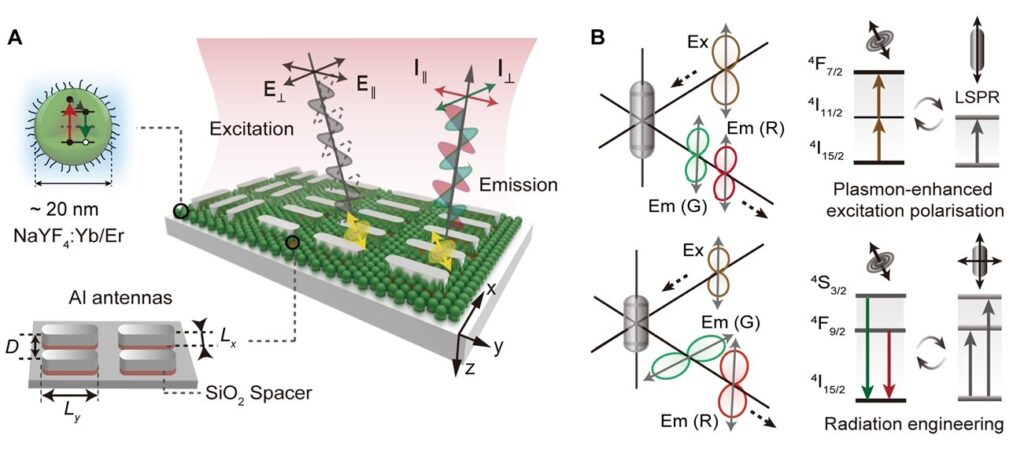National University of Singapore (NUS) researchers have introduced an upconversion plasmonphore platform to enable precise control over the polarization of isotropic upconversion nanoparticles (UCNPs). This is achieved by coupling upconversion activators with carefully designed anisotropic gap plasmon mode-supported metasurfaces.
Photon-plasmon coupling in hybrid systems is a powerful tool for investigating light-matter interactions at the nanoscale, with potential applications in various fields, including miniaturized solid-state lasers, ultracompact spectrometers, on-chip molecular sensing and polarimetric imaging. Lanthanide-doped UCNPs are particularly promising as quantum light sources due to their distinct emission peaks, large anti-Stokes shift and excellent photostability.
The characteristic spectroscopic fingerprints provided by these emission peaks make it easier to accurately identify information. While upconversion hybrid systems have been explored to enhance photoluminescence and decay dynamics through surface plasmon-photon coupling, the crystal lattice symmetry of small UCNPs makes it difficult to achieve polarization anisotropy. Also, control of the light polarization is essential for diverse applications, such as information encoding, display technology and biological sensing.
A research team led by Professor Liu Xiaogang from the Department of Chemistry, NUS, has conceived an approach to achieve precise polarization control over isotropic UCNPs by coupling upconversion activators with complex nanostructures, known as anisotropic gap plasmon mode-supported metasurfaces. The research is published in the journal Chem.
By employing metallic rod-like antennas, the researchers were able to control the light polarization of these isotropic UCNPs in a way that is similar to tuning a radio to different radio stations. This allowed them to control the light polarization of these isotropic UCNPs from the visible to near-infrared range, overcoming the constraints posed by their crystalline symmetry.
The metal-insulator-metal design ensures that there are strong double resonant modes in orthogonal directions with minimal interference with each other. It also decouples the processes involved in light excitation and emission.
By using both far-field excitation and near-field electromagnetic interference, the isotropic UCNPs can be controlled to produce periodical variations in emission amplitude, with a large excitation polarization sensitivity of up to 83%.
The research team further explored how the local density of light particles around the antennas affects the way energy is released from the hybrid nanoplatform. By exciting the system linearly, this hybrid nanoplatform can switch between four upconversion polarization states, allowing multiple levels of light output in parallel or orthogonal polarization configurations.
Their numerical investigation further shed light on how the anisotropic plasmon modes selectively affect the polarization state of the emitted light. Specifically, when the excitation enhancement factors are much larger than the emission enhancement factors, the upconversion polarization state is determined by the excitation polarization, leading to parallel polarization characteristics.
Conversely, when the emission enhancement factors are comparable to the excitation enhancement factors, the coupled upconversion emitters produced emitted light with anisotropic properties.
Prof Liu said, “The multilevel upconversion polarizations could pave the way for innovative photonic systems, offering the flexibility to tailor light frequencies and directions that use light in unique ways. This opens up exciting prospects for developing compact devices that leverage light in novel ways for advanced photonics.”


